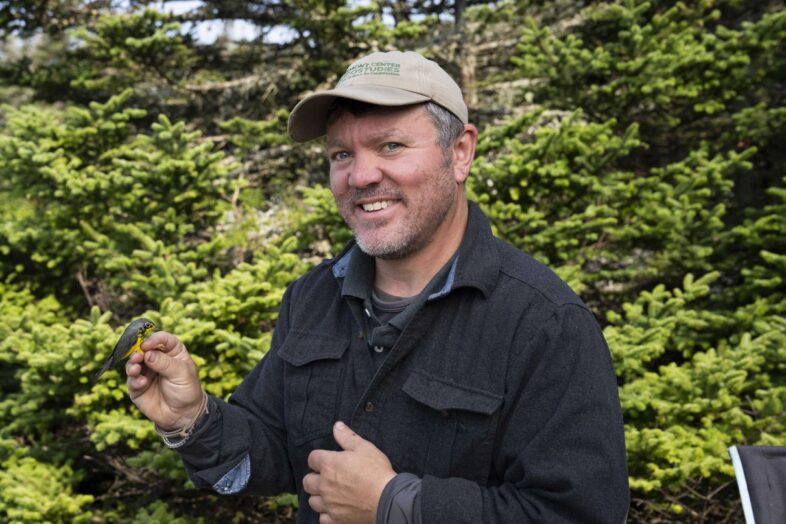 Mike is a wildlife ecologist who takes a full annual cycle approach to understand the interplay between the environment and population demography. To do this, it’s imperative to understand animal movement at multiple spatial scales–from fine-scale habitat selection of individuals to intercontinental migrations of populations. Identifying how different phases of the annual cycle interact to shape individual, population, and community dynamics is essential to understand how wildlife populations respond to global change.
Mike is a wildlife ecologist who takes a full annual cycle approach to understand the interplay between the environment and population demography. To do this, it’s imperative to understand animal movement at multiple spatial scales–from fine-scale habitat selection of individuals to intercontinental migrations of populations. Identifying how different phases of the annual cycle interact to shape individual, population, and community dynamics is essential to understand how wildlife populations respond to global change.
Prior to joining VCE, Mike served as a Postdoctoral Research Associate at the Cary Institute for Ecosystem Studies. He completed his PhD in Environmental Science & Public Policy at George Mason University, and received his BS and MS in Biology at Plymouth State University. Mike’s research has a strong applied conservation component that aims to 1) reveal the mechanisms that drive behavior, life-history and demographics of wildlife populations, 2) identify where migratory individuals and populations are throughout the year to better inform conservation and 3) determine when and where wildlife populations are limited. Through the combined use of field research and sophisticated modeling techniques, Mike’s research has helped inform conservation efforts across geographic and political boundaries.
Google Scholar
RECENT PUBLICATIONS
Morelli, T. L., M. T. Hallworth, W. V. DeLuca, T. Duclos, A. Ells, S. Faccio, J. Foster, K. P. McFarland, K. Nislow, J. Ralston, M. Ratnaswamy, and A. Siren. 2025. Does habitat or climate change drive species range shifts? Ecography.
Repenning, M., A. E. Jahn, M. T. Hallworth and C. Suertegaray Fontana. 2025. Tracking tiny migrants: First description of the annual cycle of Sporophila seedeaters. Ornithological Research. 33:15.
Hostetler, J. A., E. B. Cohen, C. M. Bossu, A. L. Scarpignato, K. Ruegg, A. Contina, C. S. Rushing, and M. T. Hallworth. 2025. Challenges and opportunities for data integration to improve estimation of migratory connectivity. Methods in Ecology and Evolution.
Sirén, A. P. K., M. T. Hallworth, J. R. Kilborn, C. A. Bernier, N. L. Fortin, K. D. Geider, R. K. Ratry, R. M. Cliche, L. S. Prout, S. J. Gifford, S. Wixsom, T. L. Morelli, and T. Wilson. 2024. Monitoring animal populations with cameras using open, multi-state, hierarchical models. Ecology and Evolution ece3.70783.
Hallworth, M. T., A. P. K. Sirén, W. V. DeLuca, T. R. Duclos, K. P. McFarland, J. M. Hill, C. C. Rimmer, and T. L. Morelli. 2024. Boom and bust: the effects of masting on seed predator range dynamics and trophic cascades. Diversity and Distributions 30:8 e13861.
Jahn, A. E., J. Cereghetti, M. T. Hallworth, E. D. Ketterson, T. B. Ryder, P. P. Marra and E. Derlindait. 2023. Highly variable movements by Andean Flamingos (Phoenicoparrus andinus): implications for conservation and management. Avian Conservation and Ecology 18.
Lewis, W. B., R. J. Cooper, M. T. Hallworth, A. R. Brunner, and T. S. Sillett. 2023. Light-level geolocation reveals moderate levels of migratory connectivity for declining and stable populations of Black-throated Blue Warblers (Setophaga caerulescens). Avian Conservation and Ecology 18.
Schaffner, F. C., M. T. Hallworth, M. F. Jimenez, I. Rodríguez-Colón, and N. E. Seavy. 2023. Light-level tracking of Northern Waterthrush (Parkesia noveboracensis): lessons learned from wintering ground deployments. Journal of Field Ornithology 94(4):5
Lewis, W.B., Cooper, R.J., Chandler, R.B., Chitwood, R.W., Cline, M.H., Hallworth, M.T., Hatt, J.L., Hepinstall‐Cymerman, J., Kaiser, S.A., Rodenhouse, N.L. and Sillett, T.S., 2023. Climate‐mediated population dynamics of a migratory songbird differ between the trailing edge and range core. Ecological Monographs, 93(1), p.e1559.
Doser, J. W., W. Leuenberger, T. S. Sillett, M. T. Hallworth, and E. F. Zipkin. 2022. Integrated community occupancy models: A framework to assess occurrence and biodiversity dynamics using multiple data sources. Methods in Ecology and Evolution 13:919–932.
Meehan, T.D., …M.T. Hallworth,…et al. 2022. Integrating data types to estimate spatial patterns of avian migration across the Western Hemisphere. Ecological Applications 32(7):e2679.DOI:10.1002/eap.2679
Ryan, T. P., B. O. Barrera, S. H. Aquez, and M. T. Hallworth. 2022. Movements and asynchronous nesting of the Peruvian Tern (Sternula lorata) in Chile and Peru. Marine Ornithology 50: 63-69.
Hagelin, J. C., M. T. Hallworth, C. P. Barger, J. A. Johnson, K. A. DuBour, G. W. Pendelton, L. H. DeCicco, L. A. McDuffie, S. M. Matsuoka, M. A. Snively, P. P. Marra, and A. Taylor. 2021. Revealing migratory path, important stopovers and non-breeding areas of a boreal songbird in steep decline. Animal Migration 8:168–191.
